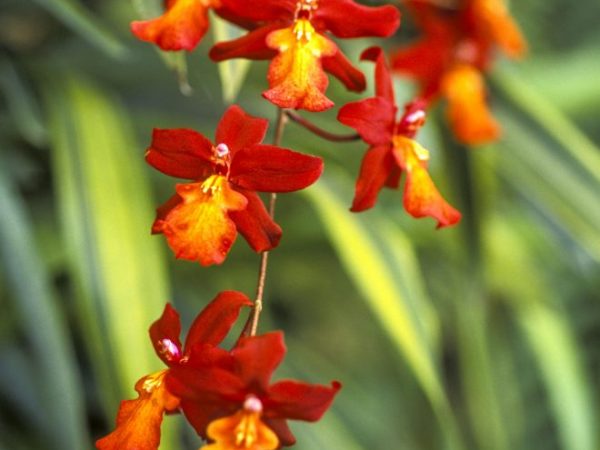Growing Epidendrum Orchids
Epidendrum orchid is considered one of the many species from the orchid family. Under natural conditions, it is found in the subtropics and tropics of South and North America. It is also grown as a houseplant.

Orchid Epidendrum
Botanical characteristic
General external features of the plant:
- branched short rhizome - aerial creeping shoot of all plant species;
- foliage is tough, thick, close to succulents, arranged in pairs on thin stems, has the shape of a lancet with a pointed end or a wide-oval shape with a concave shape, similar to a boat or scoop;
- inflorescences are formed by multiple flowers in the form of a ball, ear or brush, have a rich color, can be from 1cm to 14cm in diameter.
Home-grown epidendrum varieties:
- rooting - it is distinguished by spherical inflorescences of bright red color;
- cross - blooms in red, orange, yellow and purple;
- ciliated - has carpal fragrant green-yellow inflorescences;
- ivory - stands out with flowers of a shade of light ocher;
- crescent - blooms with single green-white flowers;
- Panamanian - is one of the novelties in gardening, has sharp-petaled flowers of lilac-pink color.
Microclimate requirements
Caring for the epidendrum at home involves creating a suitable microclimate for the plant.
Temperature
Prefers a moderate and moderately warm regime with a drop in daily temperature. The level of heat during the daytime should be maintained within the range of 18-25 ° С, at night - 12-16 ° С.
A temperature drop of more than 6 ° С provides an extension of the flowering period of the plant.
In the absence of a threat of the onset of sharp frosts, the flower is exposed in the spring and summer to the street - in the garden or on the balcony loggia.
Shine
Requires good lighting throughout the year, but needs protection from direct sunlight. A suitable place is a windowsill in the west or east of the room. When the flower is located in the southern part of the apartment at noon, it requires shading from the sun.
It is not recommended to place a plant in the north, but this option is possible if additional lighting is provided using phytolamps with a level of at least 6000 lux, extending daylight hours to 10-12 hours, especially in the autumn and winter periods.

Light for Epidendrum
Humidity
Does not require excessive moisture. The optimal mode is from 50 to 70%. To maintain this level, expanded clay is poured into the pallet and a little liquid is poured into it. Twice a day, the foliage of the flower is moistened with a sprayer.
Water temperature for irrigation is 30-45 ° С. Water the flower by immersing the container for half an hour in a basin of water. Watering frequency - as the bark dries up, preventing it from completely drying out.
The choice of soil mixture and capacity
A suitable soil mixture for the plant includes pine bark, peat, sphagnum moss, charcoal.At the same time, the pine bark acts as a block on which the rhizome and the root system of the plant are attached, and the sphagnum moss serves as protection against rapid evaporation of moisture.
Containers for growing an epidendrum at home are selected for each individual variety:
- large species are planted in pots,
- compact flowers are grown in blocks.
Fertilizing complexes intended for orchids are added to the soil mixture every 2-3 weeks. Top dressing is done simultaneously with watering.
Transplant and reproduction
Epidendrum is transplanted every 3-4 years. With excessive acidification of the soil mixture or decomposition of the block, they do this earlier. The transplant period is at the end of the flowering stage.
The orchid does not have a rest period.
Reproduction is carried out taking into account the variety:
- children growing up on shoots,
- dividing the rhizome,
- rooting of the apical part, which has formed aerial roots.
When dividing a bush, it is required to leave at least 3 developed pseudobulbs or processes on each part. In the process of reproduction, children wait for the appearance of large roots and then cut the baby from the mother's flower.
Conclusion
In Russian floriculture, the epidendrum is rare and is preferable for growing by flower growers who have experience in breeding and caring for them. Newbies with a whimsical orchid variety can have a number of problems.


